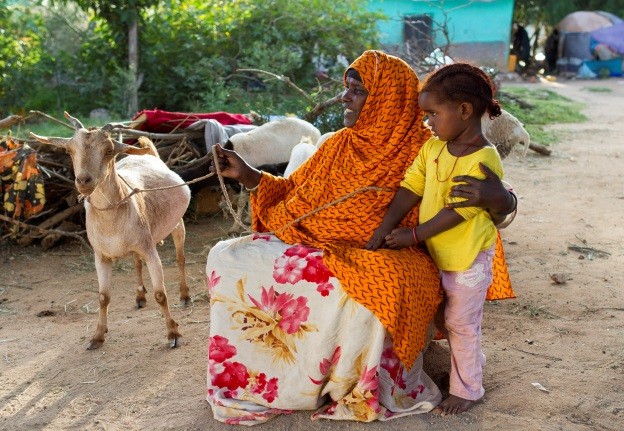Speeches Shim

Africa’s drylands are vibrant centers of livestock trade and mobility, with populations renowned for their ability to survive in harsh environments. Despite their adaptability, however, worsening conditions have challenged even their survival skills. Over the last decade, international donors have spent roughly $90 billion in just nine countries with large dryland areas, accounting for almost 50 percent of all humanitarian assistance in the world.
While we cannot stop natural disasters from happening in dryland areas, USAID must do more to help people withstand them. USAID and its partners have been in the vanguard of international momentum to enhance the resilience of people living in areas of chronic shock – especially the dry lands of the Horn of Africa.
Our efforts contribute to reduced vulnerability and more-inclusive growth. Our programs increase adaptability, reduce risk and improve social and economic conditions of vulnerable populations. We help communities transition from being recipients of emergency relief to having the capacity to prepare for and recover from shocks, such as drought.
To achieve these goals, we have developed innovative ‘‘resilience’’ programs in Ethiopia, Kenya, Somalia, Uganda and at the regional level. We work closely with national governments, development partners and regional bodies, such as the Intergovernmental Authority on Development (IGAD). USAID established the Horn of Africa Resilience Network (HoRN) [formerly known as the Joint Planning Cell] to support the use of mutually enforcing activities to build resilience capacities to shocks and tracks progress through the Regional Resilience Framework Monitoring Protocol. It also supports learning and collaboration across the network. Below are brief summaries of our resilience work implemented in the region.
ETHIOPIA
Ethiopia is home to the largest livestock population in Africa. Large numbers of the country’s cattle, goat, sheep and camels come from pastoral areas, where communities are vulnerable to extreme poverty in times of drought. To stimulate more-inclusive economic growth in the region, USAID supported the development of the Jijiga Export Slaugtherhouse, which is the first export slaughter house in pastoral areas creating a market closer to the country’s main source of animals. The operation will create new Middle East market opportunities for pastoral communities. Similarly, Ethiopia mission supported the establishment of two milk processing factories one each in Somali and Afar Regional States to create market for milk to pastoral communities and supported the establishment of Afar Micro Finance Institute to improve access to finance.
The Government of Ethiopia Productive Safety Net Program (PSNP) is one of the largest safety net programs in the world. It is a major component of Government of Ethiopia Food Security Program and plays a critical role in building resilience of chronically food insecure communities to shocks. The program has helped reduce total poverty in Ethiopia by 25% since 2005. The PSNP objective is to prevent depletion of household assets, stimulate markets, improve access to services and rehabilitate and enhance the natural environment through labor-based public works. The program has nearly eight million beneficiaries. USAID is the largest bilateral donor to the PSNP. Through this support, food gaps have narrowed, household diets have improved and fewer households needed to sell assets to meet their food needs.
KENYA
The Partnership for Resilience and Economic Growth in Kenya (PREG) brings together humanitarian and development partners to build resilience among vulnerable pastoralist communities in northern Kenya. USAID PREG works with the Kenya National Drought Management Authority (NDMA) and county governments to coordinate resilience and economic growth activities. PREG targets nine arid and semi-arid counties. It builds on community-identified strengths and priorities, tapping into the remarkable survival abilities of local populations.
Priorities include increasing adaptability, reducing risk, and improving social and economic conditions to target the causes of vulnerability. USAID is integrating humanitarian and development assistance to improve livelihoods. It strengthens the livestock value chain, enables access to Water, Sanitation and Hygiene services, increases conservation, improves governance, promotes conflict mitigation, and promotes inclusiveness and gender responsiveness.
SOMALIA
The Office of U.S. Foreign Disaster Assistance, Office of Food for Peace and the Somalia Office have launched three jointly funded, multi-sectoral programs to enhance the resilience of targeted households and communities in Somalia. These three-year programs integrate USAID humanitarian and development funding to reach 145,000 beneficiaries. The program objectives are to increase the capacity of households and communities to adapt to recurrent shocks; build on the ecological, social, and economic capital of households and communities; and promote robust learning among communities, implementers, USAID, and others.
UGANDA
USAID in Uganda is building resilience to recurrent crisis in all seven districts of Karamoja. Armed conflict has dramatically reduced in recent years and although the region is still subject to humanitarian crisis and periodic drought, multi-stakeholder interventions are increasingly development focused. The mission is piloting new interventions to strengthen the livestock sector and develop livestock value chains. USAID/Uganda has established the Karamoja Resilience Support Unit (KRSU), a research, coordination and capacity building platform that is assisting development partners to harmonize approaches and test what works and what may not. KRSU is also building the capacity of the Office of the Prime Minister's Karamoja Affairs Bureau, as well as supporting the multi-donor joint analyses and planning processes of the Karamaoja Development Partners' Group (KDPG). Existing USAID programs support agriculture, health, education, water, nutrition and biodiversity conservation.
EAST AFRICA
To support resilience building in the region, USAID developed three regional programs which promote common standards and procedures in animal health, encourage peace building and conflict mitigation and provide climate change data tools. These activities complement a regional resilience plan developed by IGAD and its member states, the IGAD Drought Disaster Resilience and Sustainability Initiative. IGAD continues to drive the resilience agenda, and USAID is helping strengthen its capacity to deliver on it.
East Africa has a regional learning project which promotes communities of learning and collaboration for improved resilience programming and pro-resilience policies brings together bilateral and regional partners to share lessons learned and advance innovation on resilience in East Africa.

Comment
Make a general inquiry or suggest an improvement.